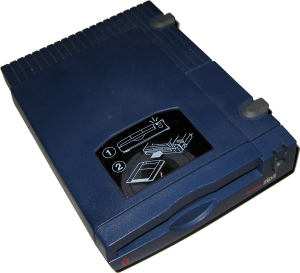
Pity poor old Iomega. The company responsible for hot products like the Zip drive and coulda-beens like the Clik drive was stumbling in the early part of this decade, unable to distinguish itself from all of the other providers of commodity external storage devices for consumers. Although the company had built the Zip into a viable floppy drive successor, USB “thumb drives” took that market by storm, replacing removable disks with flash memory.
The company was working to break into the small business market in the middle of this decade, offering Rev disk-based backup, small desktop and rack-mount NAS servers, and internet storage in addition to well-regarded software add-ins. But by that time, Maxtor, Seagate, and Western Digital had come to dominate the external USB drive market, and Lexar, PNY, and the like had taken over the removable world.
Then EMC stepped in with their March, 2008, $178 million buyout offer. Iomega rebuffed the offer at first, since it was in the process of being merged with China’s Excelstor. But after some apparently tough back and forth between the companies, Iomega finally accepted a $213 million offer in early April, completing the acquisition in June. Although it made sense for EMC to move down-market, as Cisco did with their similar Linksys acquisition, many wondered how this would work out, especially when one considers the contentious buyout process.
We needn’t have worried – ever since the EMC buyout, Iomega has rocketed forward, introducing intriguing new products, finding synergies within EMC, and gaining mindshare. Although they still peddle commodity storage, Iomega’s new line of EMC-powered NAS systems is getting the real attention (VMware geeks especially should take a hard look at the StorCenter ix2!) But the company ought to make a few marketing changes if it is to really succeed.
EMC Throws a Lifeline
Without a doubt, it was EMC’s LifeLine software that injected the most adrenalin into Iomega. Although it predated the acquisition, LifeLine is a perfect fit for Iomega: It’s a Linux-based NAS operating system with RAID, Retrospect backup, integrated media services (compatible with iTunes, Xbox, Wii, and UPnP), print services, and unusual features like Picture Transfer Protocol, Bluetooth, and Axis surveillance storage.
It’s a great combination of home features, and Iomega quickly launched a product including this software: the StorCenter ix2. Although Iomega had used the StorCenter brand name for years on a variety of NAS devices, the ix2 was the first to use EMC’s LifeLine software. The combination of Iomega, LifeLine, and Retrospect makes for a compelling home product, and many a “terabyte home” is switching to the platform. But the product’s inherited industrial design is plain (one blogger suggested it had a Wife Acceptance Factor issue), and the naming is confusing. A casual shopper would have no way of differentiating the various StorCenter products – indeed, it is difficult for me to figure out the various product lines from Iomega’s sales-oriented web site!
Predictably, Iomega is expanding their LifeLine-powered lineup both down- and up-market. The company recently introduced a smaller single-drive LifeLine-powered home NAS device, and we are hearing rumors of larger office-oriented versions. But the little guy also uses hand-me-down clothes, and is tagged with a mouthful of a name that is at once inconsistent and forgettable: Home Media Network Hard Drive. The average consumer would have no way of knowing what lurks under the skin of this home NAS, since it looks exactly like the basic USB-connected Prestige line! Why can’t the company that gave us the pretty eGo drive design something a little more attractive – check out what the competition is offering!
Moving On Up
Although their home-oriented offerings are compelling, VMware geeks should keep their eye on the upscale uses of the LifeLine platform! It hasn’t been officially announced, but EMC folks are saying that iSCSI will be added to LifeLine in short order. And the platform is already VMware certified!
Interested in building your own VMware lab? Pick up an ix2 and use NFS until the iSCSI software is added. It’s on the HCL, and makes an excellent platform for playing around with ESX! Plus, you can stream iTunes and store webcam video of your door at the same time!
Although the rest of the StorCenter line isn’t currently LifeLine powered, I’m sure it’ll be upgraded in short order. It might not be powerful enough for real enterprise computing, but a small office or lab would be well served by EMC’s kid-brother systems.
Although Iomega’s latest offerings are compelling, the company really needs to do something about its marketing. Ditch the bland and confusing names and cases and come up with something really compelling. Let buyers know which systems are LifeLine-powered and transform the web site from an online store into a site that draws attention to the unique features of these systems. Although EMC’s products might sell themselves, the consumer / prosumer / small business market is a tough one, as Iomega must already know.
Hi Steve!
I think you nailed it pretty well in capturing what EMC has brought to Iomega. There’s a few more tidbits, but you’ve captured the gist of it.
We’re all fans of slick physical design here — and Mac users — so we’d agree with you that slick packaging would be cool. Maybe too expensive, but pretty cool.
Thanks!
— Chuck
Hi Steve!
I think you nailed it pretty well in capturing what EMC has brought to Iomega. There's a few more tidbits, but you've captured the gist of it.
We're all fans of slick physical design here — and Mac users — so we'd agree with you that slick packaging would be cool. Maybe too expensive, but pretty cool.
Thanks!
— Chuck
maybe that company have big losses this past months
maybe that company have big losses this past months